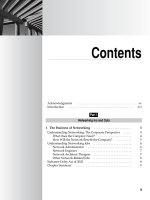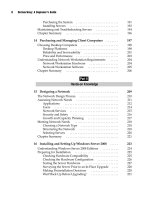Networking: A Beginner’s Guide Fifth Edition- P44 ppt
Bạn đang xem bản rút gọn của tài liệu. Xem và tải ngay bản đầy đủ của tài liệu tại đây (114.88 KB, 5 trang )
197
Chapter 14
Purchasing and Managing
Client Computers
198
Networking: A Beginner’s Guide
D
esktop computers are really where the “rubber meets the road” when it comes
to networks. These machines are the users’ primary interface to the network
and the resource on which users most rely to get their jobs done. In fact, the
network is designed to support the desktop computers’ work, rather than the other
way around. Maintaining desktop computers is also the task on which you often
spend the most time in managing a network, so their purchase, implementation, and
management are important. You can have the best network in the world, but if your
desktop computers aren’t up to the task, the network’s users won’t be productive.
This chapter focuses on the management of desktop computers. Chances are that
if you’re reading this book, you already know about the bits and bytes that make up
desktop computers and desktop operating systems. You’re probably already a wizard
with Windows or the Macintosh, and you’re comfortable installing new computer
hardware and repairing problems on desktop computers. If you don’t know about
these things yet, you can find many good books that cover the technologies in desktop
computers in detail. In this chapter, the major concern is how desktop computers
integrate with the network and how you can get the most out of them when you’re
managing or setting up a network.
Choosing Desktop Computers
Choosing desktop computers involves many considerations. Making good choices here
will pay big dividends over time. When purchasing new desktop computers, you have
the opportunity to select machines to reduce your support burden, improve end-user
productivity, and—overall—conserve your company’s cash. The following sections
explore the different factors that go into selecting desktop computers.
Desktop Platforms
You need to know which desktop computer platform you will use. Generally,
companies tend to gravitate toward either PC- or Macintosh-based desktop computers.
(These days, it is increasingly rare to find companies that depend much on Macintoshes
as a staple of their desktop computer diet.) In a few rare cases, companies might
alternatively gravitate toward Linux- or UNIX-based desktop computers, but you’ll
usually choose between PCs and Macintoshes.
Advantages and disadvantages exist for each platform. Regardless of the specific
pros and cons, you’re much better off if you can keep the company standardized on
a single desktop computer platform. Companies that have purchased their desktop
computers in accordance with individual user preferences (users are free to choose a
PC, a Macintosh, or something else) end up with real support headaches, which arise
199
Chapter 14: Purchasing and Managing Client Computers
from many different sources. Supporting two desktop platforms is more than twice as
difficult as supporting one platform. Why? Consider the following:
N You need to maintain expertise in two platforms, as well as expertise in their
applications and platform-specific peculiarities. In a small company, you need
more people to keep the requisite levels of expertise on both platforms than
you would need if you had to support only one platform.
N You need to stock more spare parts and expansion hardware. Generally,
components that work in a PC won’t work in a Macintosh, and vice versa.
N You need to license and inventory more software titles (on average, twice
as many).
N Problems that would never occur with one platform or another occur when
you must support both, even in the network itself. Supporting two platforms
is more complex than supporting one, so the servers must run additional
software, must allow for the different ways that each platform works, and
so forth. All this increases the complexity of the network, and increased
complexity means less reliability for everyone.
N Interplatform incompatibilities cause problems for users who must work
together. Even if they use the same application (such as Microsoft Word) on
both PCs and Macintoshes, platform differences still exist. For example, Adobe
fonts with the same name may look and paginate differently on Macs and
PCs. Users might painstakingly format a document in Word, Excel, InDesign,
or another application available on both platforms, only to find that the other
platform doesn’t present their work in exactly the same way. When users who
frequently interact with one another have their files formatted for a variety of
platforms, the incompatibilities become a real problem.
N In some cases, you might be unable to find software titles with matching
versions available for both platforms. This usually means users who are using
a particular application won’t be able to interact with users who are using the
other platform’s functionally equivalent application. For example, Microsoft
Access is available only for Windows.
N You will be limited in the programs you can develop for widespread use.
For example, try developing a Microsoft Access-based application and
then having Macintosh users use it. They can’t, because Microsoft Access
doesn’t exist on the Macintosh, and there’s no way to use the same database
application on both platforms in such cases. You can probably exchange data,
but not the program written in Access. The same situation exists for virtually
all programming languages: They are almost universally platform-specific,
despite the efforts of their makers to make them platform-neutral. Examples of
this kind of problem are much more common than not. (One exception to this
rule is a more advanced SQL-based application that makes use of something
like an Oracle database server.)
200
Networking: A Beginner’s Guide
These examples should convince you that you’re better off running the wrong
desktop platform than running two desktop platforms. If you’re in a company where
two desktop platforms are in use, you should work toward implementing a standard
platform. This process is difficult and time-consuming, but is important both for
increasing overall company productivity and keeping IT costs at a reasonable level.
NOTE If you move into PC management, you will probably be called on to perform cost analyses
to determine which platform to choose or to justify why you chose the one you did. These exercises
include costs of new hardware and software, dealing with legacy applications or systems to which
the platform must connect, and maintaining and supporting the platform, as well as predicting the
viability of the platform in one, two, five, and ten years. Remember that the chief technical officer
(CTO) or chief information officer (CIO) usually reports to the chief financial officer (CFO), since IT
has historically been considered a cost center rather than a profit center.
After deciding whether or not to standardize on a single platform, your next
decision is which one to choose. Most often, a company has a history with a particular
platform, so sticking with that platform is usually the easiest solution, unless a good
reason exists for a change.
If you’re lucky enough to be setting up a company network for the first time, then
you get to help choose a platform. This choice should always be driven by what the
users need to accomplish, which applications they need to run, and the platform that
best supports those applications. You need to consider the full range of applications
that the company is likely to need, but the users’ needs should be the primary driver.
For most companies, this means you’ll strongly lean toward PCs as the standard.
However, for some companies, Macs are still a good idea. Generally, Macs make sense
in companies that have a strong artistic or graphic bent to their makeup, such as a web
design firm, a graphic design house, and so forth.
NOTE As you have probably already noticed, many people want to make a platform decision
based on the platform they like the best. Many people happily call themselves “PC fanatics” or “Mac
fanatics.” For some of these people, the issue rises almost to the same level of importance to them
as a religion. Such fervent brand loyalty should never influence you in making a smart business
decision. However, the presence of such strong opinions also means that you must tread carefully
when discussing platform issues with the system’s users!
If no need exists that strongly suggests a particular platform, then, for many
reasons, you should lean toward PCs. They are the most price competitive, are in the
widest use, attract the largest assortment of software and hardware developers, and
have much more infrastructure to support them. Also, for certain important business
application software categories, good solutions are available on the PC platform but
not on the Mac platform.
201
Chapter 14: Purchasing and Managing Client Computers
NOTE This book aims to be platform-neutral, but the fact is that more than 90 percent of
networked desktop computers are PCs. While this book is just as applicable to Macs as PCs, the
remainder of this chapter assumes a PC environment.
Reliability and Serviceability
The most important features to look for in any desktop computer are its reliability
and serviceability. Studies have shown that the actual price of a desktop computer is a
small percentage of its lifetime cost, which includes software costs, training costs, and
support costs.
When assessing reliability, you need to look at the whole picture. Reliability comes
from several sources:
N The computer uses tested, high-quality components.
N Those components are engineered to work well together. You can make a cake
with the best ingredients available, but if your recipe isn’t good, you still get a
bad cake. Computers are no different. Even the best components don’t always
work well together. Top-tier manufacturers test all the components that go into
their systems and ensure that they’re compatible with one another.
N A reliable combination of software is used on the unit, and whenever possible,
the software has been certified on the computer.
Serviceability is closely related to reliability. Serviceability simply means that working
on or repairing a particular computer is relatively fast and easy. Features that enhance
serviceability include cases that are easy to open (requiring no tools), quickly replaceable
internal components (such as hard disks, memory, or video cards that require simple or
no tools), and Basic Input Output System (BIOS) that is easy to update.
Serviceability is also strongly influenced by the services available from the
computer’s maker:
N Does the computer manufacturer stay current in offering updates to its
computers?
N Does its web site offer a lookup that lets you determine the configuration of a
computer based on its serial or service ID numbers?
N Is technical information about its systems readily available, or does the vendor
tend to gloss over any discovered problems?
N How quickly can you get replacement parts?
N Does the manufacturer include on-site service for a period of time that reduces
your support burden?
N What is the warranty on any given computer?









